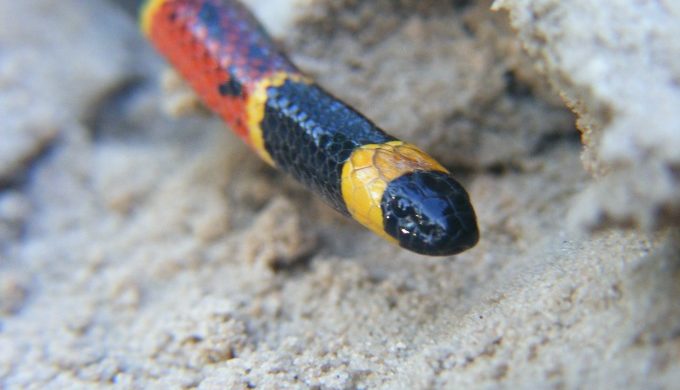In Texas, there are several snakes that we’re trained to look out for. The rattlesnake is the scariest of them all, due to their aggressive nature and the severity of their bites. The copperhead and water moccasin illicit fear in the hearts of Texans as well, as we hear stories of neighbors tangling with these critters while on the river or doing yard work. One other highly venomous Texas snake is so shy and docile that it doesn’t get nearly the same hype as the others. This snake is the Texas coral snake and, (aside from having a handy rhyme about it to differentiate it from its harmless doppelganger, the king snake) people know very little about this reclusive critter. Here are five surprising facts about the Texas coral snake.
Nature
5 Facts About the Texas Coral Snake that Might Surprise You
1. Cousin to the Cobra

Photo: Flickr/Ashley Tubbs
The coral snake has some infamous cousins. The coral snake is the state’s only member of the Elapidae family, which includes the cobras of Asia and Africa.
2. Second Strongest Venom in the World

Photo: Flickr/Brett McGhee
The coral snake has the second most toxic venom of any snake (the black mamba has the most deadly venom) in the world. However, they are generally considered less dangerous than rattlesnakes because coral snakes have a less effective poison-delivery system and don’t strike at their prey the way that rattlesnakes do.
3. Dangerous, But Not Usually Deadly

Photo: Flickr/Ashley Tubbs
According to National Geographic, though their venom is highly toxic, no deaths from coral snake bites have been reported in North America since the late 1960s, when antivenom was developed. Additionally, there is often little to no pain or swelling in humans from a coral snake bite. If untreated by antivenom, however, symptoms will take effect. These symptoms include slurred speech, double vision, and muscular paralysis.
4. Coral Snakes Are “Smart Fellers”

Photo: Facebook/Herp Keepers
Coral snakes pass gas when they feel threatened. When startled, the coral snake makes a “popping” sound out of his cloaca – a single opening for the urinary, reproductive, and intestinal tract. This “micro-fart,” as scientists call it, is used to scare away a predator.
5. Only Egg-Laying Venomous Snake

Photo: Flickr/Brett McGhee
Of the four venomous snakes native to the United States, only the coral snake is an egg-layer. The other three: rattlesnake, copperhead, and water moccasin, are pit vipers, and vipers don’t lay eggs. According to the University of Michigan Museum of Zoology Animal Diversity Web, coral snakes are the only venomous snakes in North America to do so. Babies are born brightly colored, fully venomous, and seven inches long.



